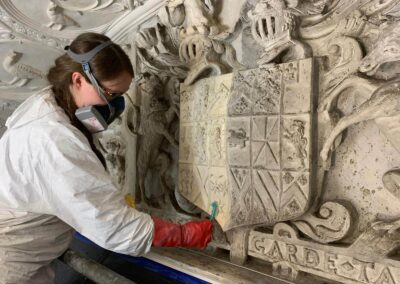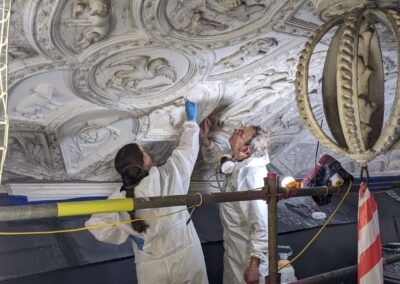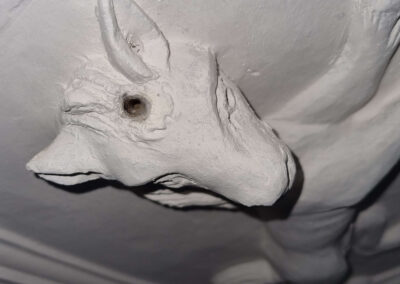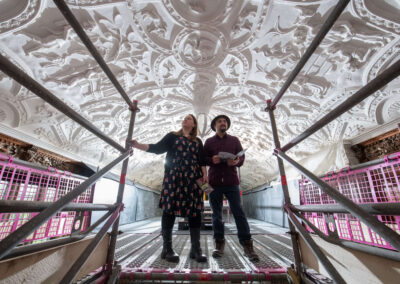CONSERVATION CLEANING AND REPAIR OF DECORATIVE PLASTERWORK
Project Overview
The Long Gallery ceiling at Lanhydrock National Trust is a masterpiece of Jacobean ornamental plasterwork. It was created between 1620-40 and thought to be the work of the Abbott family of Frithelstock near Bideford. The ceiling comprises twenty-four panels with scenes from the Book of Genesis, including Adam and Eve, Noah and the Ark, the Life of Jacob, and David and Goliath, all surrounded by more than 350 different species of animals, intricately moulded plants and mythical beasts. The whole ceiling is hand modelled in situ in lime plaster and is a tour de force of the plasterer’s art. The National Trust required Cliveden Conservation to execute an extensive programme of work to conserve and redecorate the ceiling to display it again to its most spectacular advantage.
Conservation Treatment of the Decorative Plaster Ceiling
Cleaning trials provided a methodology for removing the accumulated dirt and discoloured paint layers masking the ceiling. Conservators then meticulously cleaned the 35-metre-long, barrel-vaulted ceiling with scrubbing brushes, denture brushes and sponges. Intricate repairs were made to the plasterwork; loose elements were stabilised and lost ornaments recreated before applying a soft distemper paint finish.
During the project, visitors to Lanhydrock could access a purpose-built scaffold to view the Long Gallery ceiling at close quarters and watch the conservators at work.
Creation of the Unicorn Horns
Amongst the many repairs undertaken, the ceiling presented one unique and intriguing challenge – the two unicorns on the ceiling were missing their horns. Recreating these elements required extensive research and consultation. There was no record of the original horns, only a hole in the middle of each of their foreheads where they once fitted.
Illustrations from The History of Four-Footed Beasts by Edward Topsell, which inspired many of the ceiling’s creatures, provided insight into their general appearance. However, the horns in the illustration were significantly longer than could have been accommodated within the surrounding ribs. The team consulted with professional experts to determine the horns’ style, length and thickness.
The new horns were created from timber, the same material as most of the other attached elements on the ceiling, such as swords, staffs and tools. Pine dowels were carved to fit the existing holes, and a spiral along it created using natural jute string. The horns were then coated with gesso, attached using HMG conservation adhesive and painted with the same soft distemper as the rest of the ceiling.
Results
The extensive research, close collaboration and expert craftsmanship paid off. The unicorn horns have been restored in a manner that respected the ceiling’s history and style, and the entire process was a resounding success.
The scaffolding has now been dismantled and the collection returned into the Long Gallery, ready for the house to reopen in 2025, sparking excitement for next year’s visitors and the future of this historic site.
Project details
Lanhydrock, National Trust
Cliveden Conservation
Category:







